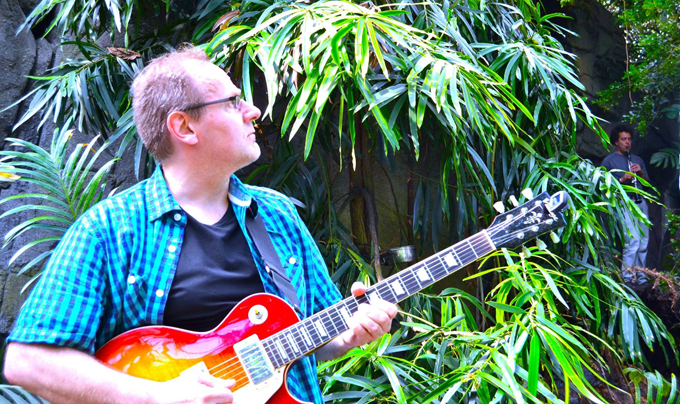
Petri Kuljuntausta is the founder of Akusmata, a sound art gallery in Helsinki, Finland. He is also an established composer and sound artist himself, and recently collated and edited the book “Sound, Art and Climate Change”, in which he and a selection of artists have written about their experience of developments in environmental sound and climate change, and how it affects their recordings. A CD “CChanges” accompanies the book. Ave Noctum writer Andrew Doherty took the opportunity to ask Petri a few questions about Akusmata, the CChanges project and about Petri’s own work.
AN: Hi Petri! I have lots to ask you about but first, may I thank you for agreeing to be interviewed. How’s it going in Finland? Are you subject to restrictions in your daily lives?
PK: Hey Andrew! Covid is a problem for us as everywhere. We can only hope that this strange period of time will end soon. Concerts and performances have been cancelled or postponed. But we just have to endure this so that more people don’t get sick. During this time, however, I have been able to finalize a number of unfinished projects, new releases are coming. So, something good has also happened.
AN: May I start by asking what sound art is?
PK: Sound art is produced from very different starting points and using different materials. What unites artists is that the starting point is sound, and new ways and methods are invented to create something interesting for the ears. No traditional instruments are used in sound art. In fact, in sound installations, each work is at the same time a unique instrument. There are many ways to do sound works, from silence to noise. Someone works with quiet sounds of nature, another with noise and drive the sounds out through the distortion pedal. Diversity is the richness of sound art. The background of sound artists can be in visual arts, punk and metal music, sculpture arts, electronic music, theater …
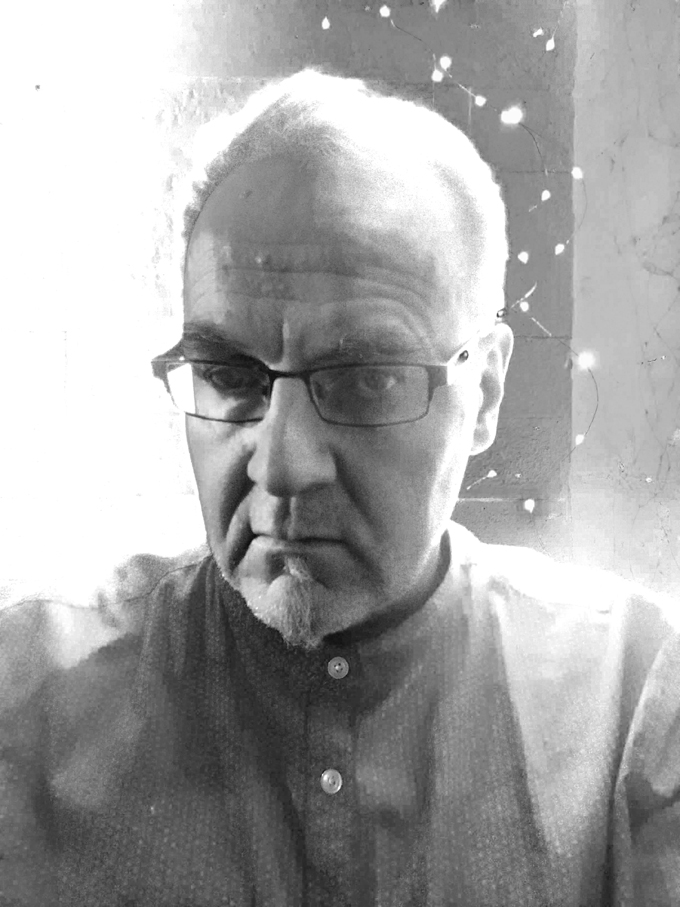
AN: You run Akusmata, the sound art gallery in Helsinki. It sounds fascinating. Can you tell us about it?
PK: Akusmata is a gallery in the basement of an apartment building. I started it as a not-for profit, artist-run gallery at the end of 2011 and the first sound installation opened in early 2012. I have had that space for a long time. The space is divided into two separate entities, a gallery and my workspace, which are connected by a corridor. Artists have access to my equipment, tools, and everything in my work. I have hundreds of speakers, a lot of PA equipment, mixers, various amplifiers, guitar amps, guitars, electronics, tools, etc. Akusmata is the only gallery in Finland that focuses on sound art.
It is a small place but important for artists. There you can do sound tests without pressure. There have also been regular concerts and sound performances. At Akusmata, visitors like that artists are close to them, they can go chat and ask about equipment or their work in general. In the intimate space, where the audience is right next to the performer, the intensity is different than on the big stage, and it has an impact: many of Akusmata’s gigs have already been released on albums.
Because Akusmata is connected to my workspace, it is easy to maintain. If I myself am not working on the workspace when the exhibition is open, then I will hire someone to supervise the exhibition. I do not take the gallery exhibition projects if I am travelling myself, playing elsewhere or giving workshops. The exhibition times are therefore short so they don’t interfere with my own work. Recently, the artists have also supervised the exhibition themselves, which has made it much easier to carry out the projects.
The good thing about a small gallery is that I can react quickly. If a foreign artist visiting Helsinki wants to do a three-day installation project or a gig at short notice, it is often possible to organize it in Akusmata. The schedules of the big art institutions, on the other hand, have been locked in for months to come, even years, and it is impossible to make additions to the program.
All Akusmata exhibitions, sound installations and also concerts and performances have been recorded – video, sound, photos. The time will come to produce a documentary based on this material.
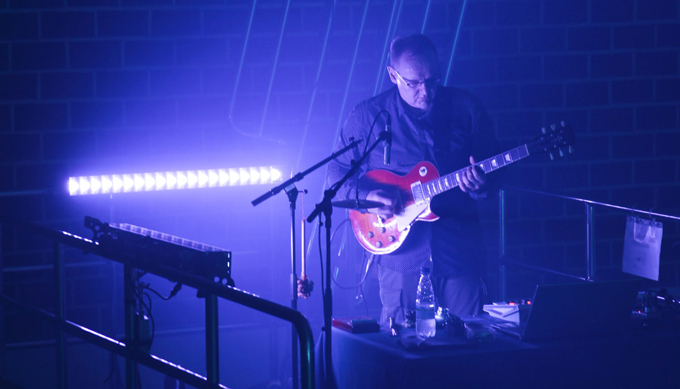
AN: Is it possible to visit Akusmata, in normal times of course?
PK: Akusmata’s exhibitions and installations are open to the public. Exhibitions and installations are projects and opening hours vary, so visitors should check the opening hours in advance on Akusmata’s website or Facebook.
AN: You say that Akusmata is the only gallery in Finland that focuses on sound art. I’m aware of cultural centres for music and dance and the like, but not of any similar galleries dedicated to sound art anywhere elsewhere in the world. Are there any others to your knowledge?
PK: I know a couple of sound art galleries in action. A few other sound art galleries have been in operation for a short time and have ceased operations. There are also listening rooms where you can go to listen to sound works. Sound works are most often presented in art galleries, even though they are designed for visual art.

AN: You mention concerts and performances. Are you involved with the Polyphonic Festival? It’s known as Akusmata Polyphonic so I guess you are. Can you describe the Polyphonic Festival?
PK: Yes, I am involved. The Polyphonic Festival is held once a year. The program includes performances of electronic music and sound art and an exhibition of sound art. The program is strongly focused on Nordic artists as the event is supported by the Nordic Culture Fund. The support of the city’s cultural office is also important, so it provides us with a first-class concert hall with state-of-the-art PA system and film and video projection capabilities. Musician Kenneth Kovasin (aka [ówt krì]) is an invaluable help in the festival’s working group, and he also helps in Akusmata when concerts are held in the gallery.
AD: It’s evident from your Akusmata site and the CChanges that there is a large number of sound artists and collaborators, many from Finland. Why do you think it is that there are so many sound artists in Finland?
PK: An interesting question! It is true that the field of sound art and electronic music is very active in Finland. The sound is of interest to many artists and there are also more and more female musicians. Many like to experiment with sound even though they don’t actually focus on sound art. It is typical of this time to experiment with different media and artists go beyond traditional art boundaries. Visual artists compose electronic music, composers make video works, performance artists use sound … anything is possible. There are many small clubs and galleries in Helsinki where interesting things happen, all with their own small dedicated audience.
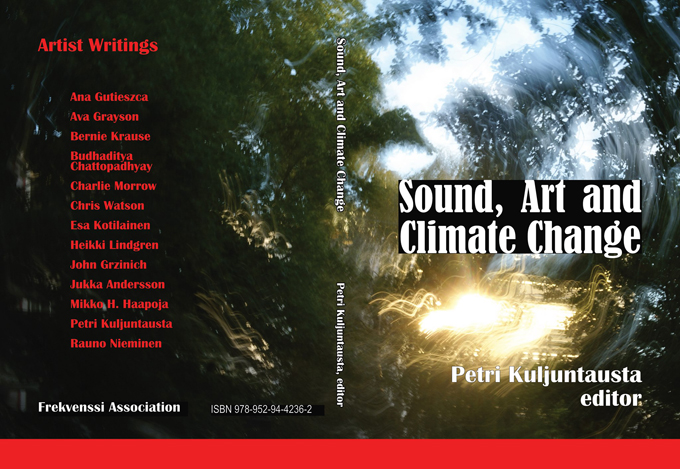
AN: Our first contact with each other came about through the “Sound, Art and Climate Change” book and the CChanges project. Can you tell us about the project, how it came about, its aims and how you managed to enlist contributors from across the world?
PK: The project started with the idea of producing new compositions, sound works and performances with the theme of climate change. The project progressed in stages and grew larger than originally thought. A sound composition and a concert-length performance were commissioned from seven artists. A gallery work, sound work or sound installation, was commissioned for the upcoming Polyphonic Festival, from the same artists. Finally, everyone wrote an article about their work. As dozens of pages of text emerged, the idea arose to make a book and invite other authors to join. I contacted sound artists I knew from all over the world, those who had dealt with the subject in their work before, and they were happy to join. Scheduling problems delayed the project, but everyone stayed involved until the end. At the beginning, of course, there was uncertainty about what was going to happen during this trip and what kind of works and writings would be created, but the further the project progressed, the more impressed I was with the results.
AN: Climate change actions are a global initiative, or should be. Where do you see the CChanges project going from here?
PK: The book and CD have just come out, and you could immediately notice how these resonate with their environment. There has been a surprising number of orders and feedback. Negotiations are currently underway with a Los Angeles-based record label and we are exploring the possibility of making the book and record editions for the U.S. market.
The purpose of the project is to spread information and views on an issue that worries many. It is not intended to preach. When climate decisions are made at the state level, artists are hardly listened to then, but it is important for all of us to say what we think about it. As the writings in the SACC book states, there have been changes in the environment. Nature sound recordists notice this after visiting the same recording location for years.
AN: You are a composer and sound artist yourself, and contributed an essay to the book, and a composition to the CChanges CD. With the prominent guitar sound and the breakdown in the middle accentuating the natural soundscape, I found your musical piece “Disappearing Shorelines” disturbing. Is that how you intended “Disappearing Shorelines” to be? What was your thinking behind the piece?
PK: The sea recordings of the composition I made on the eastern shores of the Adriatic Sea in the Mediterranean. These recording sites will gradually disappear over the coming decades due to climate change. The sea level in the area will rise dramatically, up to one meter during this century, and at the same time the land level will sink. The future of the area naturally affected the mood of the composition. The initial period of the work is more harmonious, but later the work develops so that there is more tension in it.
As for my guitar playing style, I think a lot of things have left their mark on it. Songs of birds, noises of electronic music and sound art, improvised music, ambient sounds. However, many things happen on the basis of free associations. My tendency is to develop tensions and think of music on different layers that play at the same time, instead of playing harmoniously or tonally.

AN: It’s fair to say that you have a vast catalogue of works, films, performances, broadcasts, productions and written works. What do you think have been the greatest moments of pride for you, and greatest inspirations and discoveries in your creative life?
PK: It is difficult to evaluate and value one’s own work. Usually when I get something done, I leave it behind and move on. Probably you could say that I am curious by nature and I hate routine in art. It just doesn’t suit me that once I was successful, I would stay to repeat that same formula for the rest of my life. I compose, play guitar, build sound installations, write, organize concerts and workshops, lead a gallery … I don’t plan for the future. I do what interests me. And after all, it is inconceivable that I have been able to live by doing these things.
It all started with playing the guitar and I practiced through my youth for 8 hours a day. Then I built the foundation for all later what I’ve done. All styles of music interested me and I wanted to learn how they work. I carried a pile of music and art books home from the library and studied them. I started making music with multi-track technology, then came the bands where I played. At some point, ambient sounds and electronic music took me with them. A period of years followed when I only recorded ambient sounds and made works from those sounds. It opened my ears to new sounds. There was no going back. Why use old instruments like an electric guitar when the environment is full of interesting sounds that tell us about the world we live in.
I’ve been playing with the birds, making music from the sounds of Northern Lights, made underwater sound installations and concerts where the listeners are submerged under water. I composed a work for extra-terrestrial musicians. The text score for this work travelled through space inside the ESA (European Space Agency)’s Cassini-Huygens spacecraft for more than seven years and over a distance of nearly three and a half billion kilometres. The spacecraft, and my composition, landed on the the surface of Saturn’s Titan moon in 2005. Helsinki Music Centre opened its doors in 2011 and the house has my permanent ‘Tempus’ sound installation for 100 ticking clocks. This is a state commissioned work.
The journey continues. There are a lot of plans pending and I am also trying to get old projects completed. I am currently editing an album from a studio session two years ago where another musician played the violin and shaman and ritual instruments. Almost ready is also a ‘1-2-3-4’ sound work in which I gathered the musicians’ count-ins from numerous music releases from different decades. Just counting one after the other, nothing more. These are verbal rhythmic beats that are not yet music.
When the work is based on experimental expression, I also have to accept that sometimes I fail. Fortunately, there have been more successes than failures in the stages of my career. Sometimes I remember that little gig in a small place where there were only a few listeners. You never know when you will succeed and that good moment will be crowned by the few people who appreciate what you did. Failures are also needed. They make you think about the reasons why the project went wrong and you can learn from them, and they make you think about how the project could be more successful next time.
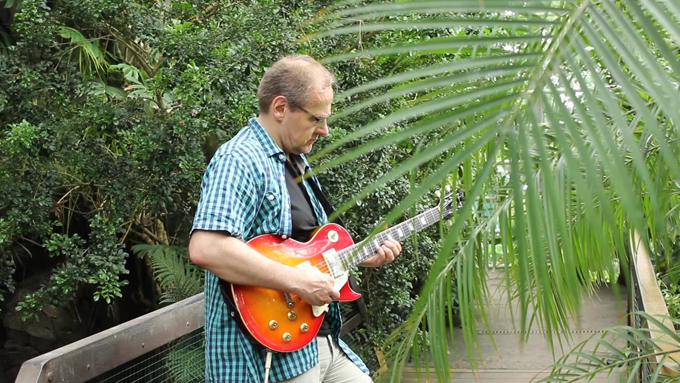
AN: Looking ahead, how do you see the future for Akusmata and yourself, creatively speaking?
PK: 18 months ago I donated more than 20 computer monitors and a few computers with a Facebook ad because I wanted more space. People thought Akusmata would stop and contacted me and said it would be terrible if that happens because its events are so important to them. There is a small but loyal audience around Akusmata and the artists know where to perform when playing experimental stuff.
I will continue to run Akusmata for as long as it feels fun. It’s great to watch closely when artists build a sound exhibition, a sound installation, or how they build a concert performance with their special sound equipment. To find a workable technical solution, I can have something to give them and give tips on new options. But in the same way, I learned new tricks from others. Organizing events sometimes has its own stress, but I like it when there’s a little pressure. Afterwards I enjoy it when I got something new done.
AN: And finally, is there anything you’d like to say to readers of Ave Noctum?
PK: Sound art is an area of art worth exploring, and I hope people are open and curious about new phenomena. There is, of course, the kind of music that everyone personally likes and find touching. But there is also music and sound art that does not immediately open up and instead raises questions: what is this about, what does this mean? Sometimes the purpose of works is to raise questions, not to give an answer. It is up to the listener. Sometimes the work reflects the world around us and presents criticism. Sometimes only one sound frequency plays in a work, but if the listener delves into it, the experience can open up a whole new sound universe.
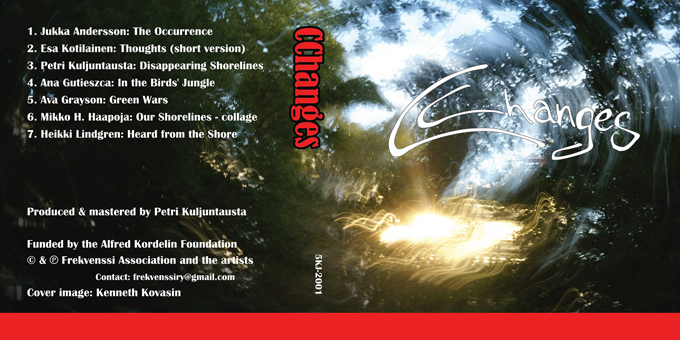
Our discussion started with the book and the CD record. They can be found here:
https://frekvenssi.bandcamp.com/merch
AN: I’d just like to express my appreciation to you for your time and thoughts. CChanges is everyone’s responsibility but it’s to the credit of yourself and your fellow contributors that you have highlighted these important issues through your art. Best wishes for the future!
Andrew Doherty
Leave a Reply